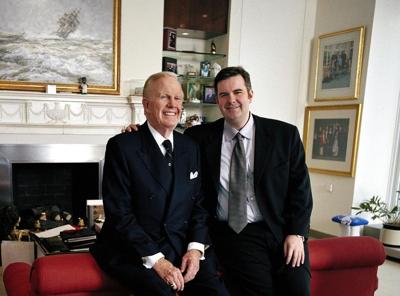The Entrepreneurs is an occasional series that will profile Canadian innovators and the lessons to be drawn from their stories. This week, itâs Ted Rogers who died in 2008 and was the president, CEO and driving force behind Rogers Communications.
The phone call that rewired Canada weighed ten pounds.
Mayor Art Eggleton needed both hands to steady the metal briefcase that hid its battery pack. At noon on July 1, 1985, he stood in Nathan Phillips Square to ring Montreal Mayor Jean Drapeau. That was Canadaâs first public cellular call.
Behind this spectacle was Ted Rogers â 52, slight, relentless. Already a force in broadcasting but nowhere near a household name, he was betting that wireless would remake how we talk, trade, bank, date and, one day, stream the Blue Jays on a streetcar.
Rogers saw mobility reshaping daily life long before the market had numbers to prove it.
Rogers put in every chip he owned â and soon he would put in lots more he had not yet borrowed. In his 1984 shareholder letter he declared, âIf youâre not a leader, youâre a follower, and followers rarely change the world.â
While competitors convened focus groups, his engineers climbed onto rooftops, bolting antennas beside chimney stacks. He lined up a war chest and scouted tower sites along Hwy. 401 from Windsor to Cornwall.
Skeptics scoffed.
In 1983, Rogers asked his board to bid on cellular licences.
âThe board thought I was crazy; they couldnât see past the upfront cost.â So he went around them, stitching together a consortium â Cantel â that won Canadaâs first national licence in 1984.
Entrepreneurship isnât about executing flawless strategies, write the authors, itâs about
Within a year, Cantelâs network lit up ÎÚÑ»´«Ã½ and Montreal. Bay Street was not impressed; analysts warned of âdangerous leverage.â The Globe and Mail also ran a story about Rogers âbetting the company on unproven technology.â
Yet that Canada Day photo-op flipped the script. Reporters were eager for details on Cantelâs scratchy but magical network. Businesses wanted car phones installed yesterday. Cantel network manager Mike Dobbin later joked, âWe were testing live with paying customers.â
Ted had run this playbook before: buying CHFI-FM in 1960 when almost no one owned an FM radio, then launching cable in 1967 while antennas were free. Both times pundits yelled ânutsâ â both times he won.
Cellular, though, was much bigger. Towers, digital switches, spectrum fees â millions up front. Would anyone really lug a shoebox phone and pay three dollars a minute? Ted thought so.
On a 1990 analyst call he quipped, âTechnology never asks permission; it just shows up and rewrites the rules.â
Early adopters were hardy souls. Motorolaâs original DynaTAC weighed about 2½ pounds and cost $3,995 â plus airtime. Coverage was patchy; drop one call and you were out ten bucks.
That ‘crazy’ bet now fuels more than $55 billion in GDP
By the mid-1990s, phones shrank to pocket size. Digital networks delivered clearer calls. Text messaging arrived. That ‘crazy’ bet now fuels more than $55 billion in annual Canadian wireless GDP.
The Rogers playbook offers a blunt lesson for every founder: conviction often precedes consensus.
Which is why the accomplishments of his son Edward Rogers are all the more impressive.
In 2023, Edward Rogers and his team closed the $20-billion acquisition of Shaw Communications, cementing the countryâs largest cable footprint with a next-generation wireless network. The move gave Rogers scale in both urban cores and rural main streets.
Then there is sports.
Rogers already owned the Blue Jays and Sportsnet; the next leap was to grow from a national broadcaster into a global sports empire.
Edward Rogers, alongside his longtime business partner Roger Rai, has invested in the ÎÚÑ»´«Ã½ Blue Jays in every conceivable way, from recruiting a star sushi chef in anticipation of the Shohei sweepstakes to overseeing a half-billion-dollar ballpark renovation. Passionate about tennis, he is arguably the single most strategic backer of the sport in Canada.
Rogers now leads the worldâs pre-eminent sports conglomerate
And then: capturing control of MLSE, combining the Blue Jays, Raptors and Leafs under one umbrella, is nothing short of stunning. The hockey team is no mere hockey team; it is an iconic brand. The Raptorsâ exclusivity in Canada makes it equally special.
Edward Rogers is now leading the worldâs pre-eminent sports conglomerate. The pending sale of the Lakers and the recent sale of the Boston Celtics (without a stadium) both point toward growing value for Rogers Sports.
Sports offers vertical integration. Live games anchor prime-time ad dollars, drive broadband upgrades and fill wireless data buckets. After a game at Rogers Centre, fans reload highlights on Rogers-powered phones. That closed loop is what venture capitalists call a platform moat.
Edwardâs lesser-known initiatives â from real-estate plays to luring an NFL team to ÎÚÑ»´«Ã½ â suggest even more upside.
Both Ted and Edward Rogers have taught founders a valuable lesson when eyeing their own moon shots: scale your conviction. When opportunity tilts your way â a regulatory window here, an ownership shuffle there â bet like consensus is overrated.
The Rogers family name itself is respected nationally. Edward Rogers took that name, faced crushing expectations, and proved that lightning can strike twice.
The late Ted Rogers was as quotable as Yogi Berra. As he told the Empire Club in 2006, âThe surest way to predict Canadaâs future is to build it yourself â then keep building while everyone else debates the odds.â
































To join the conversation set a first and last name in your user profile.
Sign in or register for free to join the Conversation